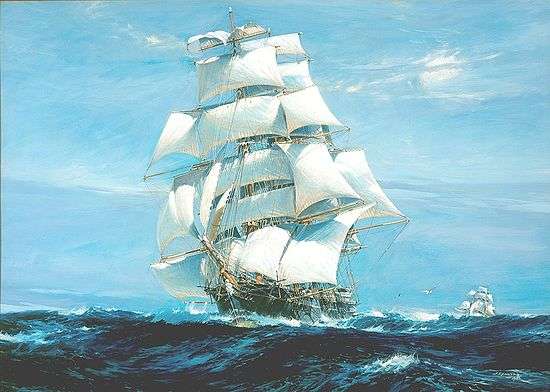Ariel (clipper)
 Ariel and Taeping in The Great Tea Race of 1866 | |
| History | |
|---|---|
| Name: | Ariel |
| Builder: | Robert Steele & Co., Greenock |
| Launched: | 1865 |
| Fate: | Foundered 1872 |
| General characteristics | |
| Class and type: | Clipper |
| Tonnage: | 852.87 NRT[1] |
| Length: | 197.4 ft (60.2 m)[1] |
| Beam: | 33.9 ft (10.3 m)[1] |
| Depth: | 21 ft (6.4 m) [1] |
Ariel was a clipper ship famous for making fast voyages between China and England in the late 1860s.
Ariel was a full rigged ship of 853 tons net register, measuring 197.4 feet (60.2 m) x 33.9 feet x 21 feet (6.4 m). She was designed by William Rennie, and built in 1865 by Robert Steele & Co., Greenock for Shaw, Lowther & Maxton of London. Like the majority of tea clippers launched after 1864, she was composite built, of timber planking over iron frames.[2](p136)
Ariel is most famous for almost winning The Great Tea Race of 1866, an unofficial race between Foochow, China and London with the first tea crop of the 1866 season.
Great Tea Race of 1866
Premium prices were paid for the first consignment to reach London. The clipper Fiery Cross left Foochow on 29 May and Ariel, Taeping and Serica on the 30th. On 6 September Taeping docked twenty minutes ahead of Ariel, and about two hours ahead of Serica. Fiery Cross and Taitsing arrived two days later.

After 99 days and almost 16,000 miles (26,000 km) the leaders were still tied and raced side by side the full length of the English Channel and into the Thames. Taeping, under Captain McKinnon, drew less water and was able to tie up in the London docks twenty minutes ahead of Ariel, under Captain Keay. Taeping divided her winnings of 10 shillings per ton with the crew of Ariel and Captain McKinnon divided the captain's £100 with Captain Keay, who hailed from Anstruther.
With the completion of the Suez Canal the tea trade was taken over by steamships and most of the clippers transferred to the Australian trade, carrying general cargo to either Sydney or Melbourne, and returning with wool — for which a premium price was also paid on the first shipments of the season.
Loss of the ship
Ariel sailed from London for Sydney on 31 January 1872, but failed to arrive. She is assumed by most who knew her to have been fatally pooped - her fine lines always made her at risk of this.[2](p157)[3](p55) Around August 1872 the remains of a teak-built ship's life-boat carrying a brass fitting with the gothic-script letter A were found on King Island in Bass Strait. It was believed to have come from the missing vessel, which, if the assumption was correct, probably foundered in the Southern Ocean after rounding the Cape of Good Hope.
References
- 1 2 3 4 MacGregor, David R. (1983). The Tea Clippers, Their History and Development 1833-1875. Conway Maritime Press Limited. p. 152. ISBN 0 85177 256 0.
- 1 2 MacGregor, David R. (1983). The Tea Clippers, Their History and Development 1833-1875. Conway Maritime Press Limited. ISBN 0 85177 256 0.
- ↑ Campbell, George F. (1974). China Tea Clippers. Adlard Coles Ltd. ISBN 0-229-11525-X.
- Basil Lubbock, The Tea Clippers, Brown, Son & Ferguson, Glasgow
- Graeme Broxam & Michael Nash, Tasmanian Shipwrecks, Volume I, 1797-1899, Navarine Publishing, Canberra, 1999
- Captain Alexander Rodger of Cellardyke
External links
- Winchester, Clarence, ed. (1937), "The famous Ariel", Shipping Wonders of the World, pp. 188–191